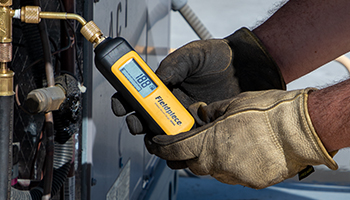
From digital manifolds to manometers, many of the HVACR tools we use every day are practically indispensable. If you install a new A/C unit or recharge a unit after a repair, you can add a digital vacuum gauge to your list of indispensable tools. They’re much more accurate than analog gauges with improved accuracy. You’ll know that all moisture, non-condensable gasses, and contaminants are removed and that your system won’t leak refrigerant.
Let’s dive into a few of the best ways to use a digital vacuum gauge. For starters, you might already have a vacuum gauge on your digital manifold. In a pinch, you can use this gauge, but it isn’t a best practice. A standalone digital vacuum gauge HVAC technicians connect directly to the system will be unaffected by leaky hoses, valves, and other connections between the manifold, the pump, and the system.
Before using the vacuum gauge, it’s important to pick the right location to install it. Sure, the easiest location is the area right next to the pump, however, this should be avoided. Instead, pick a location on the system that’s as far as possible from the pump itself, for the same reason you won’t install a thermostat right over a supply vent. Placing the gauge far away from the pump will give true visibility that the entire system reached the system-recommended vacuum or 500 microns as a rule of thumb.
Once the pump is up and running, be sure you understand what the readings on the vacuum gauge mean. You may see fluctuations. But these fluctuations are normal, and they can be caused by a host of factors. When the pump is running, every hose and O-ring in the system may adjust slightly. Each adjustment could release a bit of gas. Even this small amount could cause the gauge values to fluctuate. This should stop over time.
Also, after you’ve reached 500 microns and isolated the pump, you may notice a spike in the vacuum reading. This could be caused by the ball-valve connection to the vacuum pump. This valve can sometimes trap a small bit of air inside, causing your readings to spike. To mitigate this, periodically open and close the valve during evacuation.
The next step is to make sure that the system can hold steady pressure. If the micron value increases quickly and never stops until it reaches atmospheric pressure, you know you have a leak somewhere. This merits an investigation. If the system can’t hold a vacuum; it won’t hold refrigerant.
You may also notice the pressure slowly increasing and leveling off higher than 1,000 microns. This means you still have moisture in the system. Start by making sure the oil in your vacuum pump is fresh. If it isn’t, replace it and continue your evacuation. If lots of moisture is still present, you may need to flush nitrogen through the line set. This will remove the excess moisture and help you pull a vacuum to the system-recommended pressure.
Pulling a vacuum is an important part of being an HVACR technician, and the right tools ensure the job is done right. For help with a digital vacuum gauge HVACR technicians can depend on, visit Fieldpiece.com today.